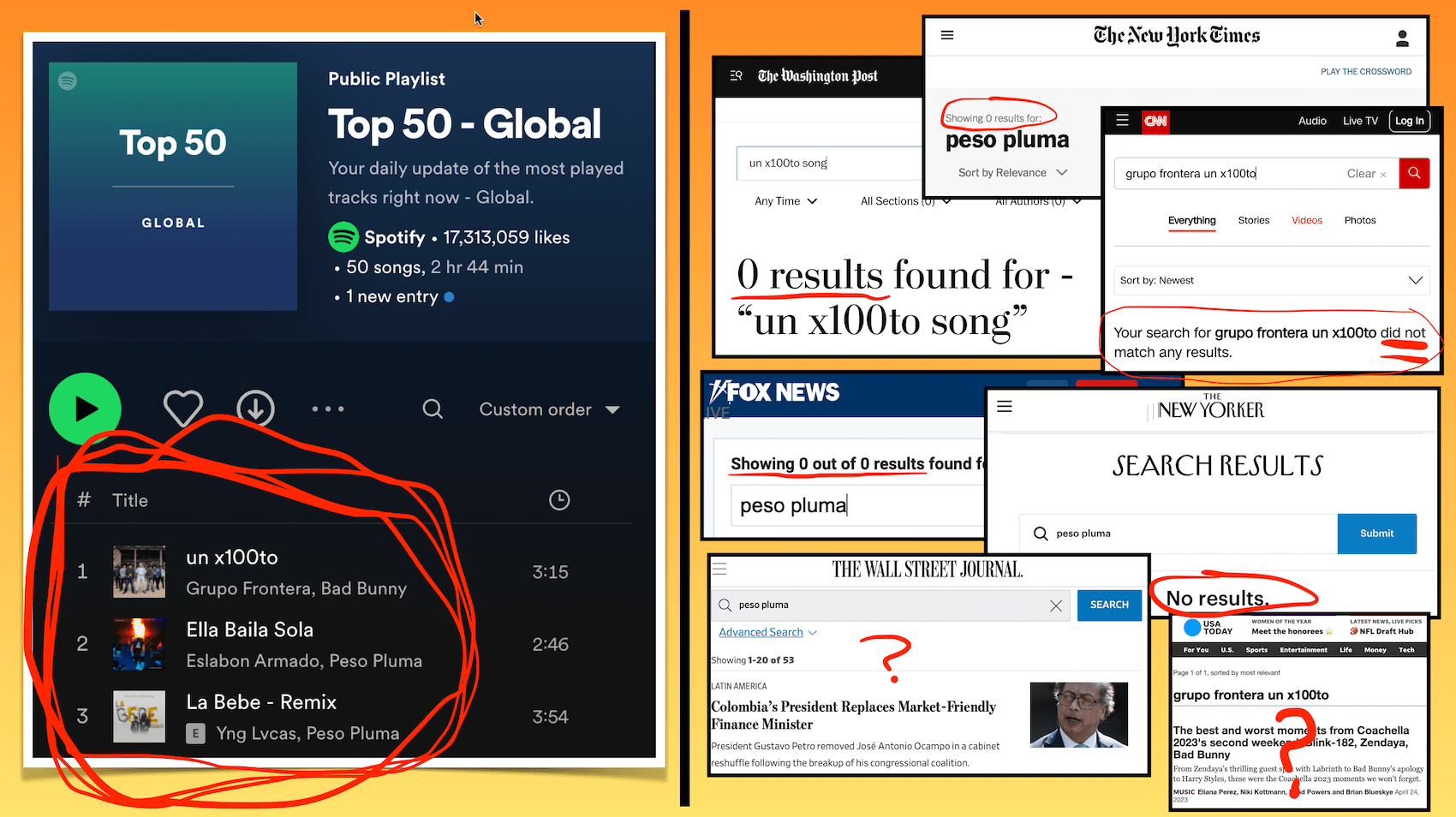04.30.2023 | By Jack Rico |
America is currently experiencing a Latino renaissance. Music festivals like Coachella are prominently featuring Latino artists. Groundbreaking Latino-led superhero films like “Blue Beetle” are hitting theaters. Actors like Pedro Pascal, Jenna Ortega, and Aubrey Plaza are hosting Saturday Night Live, while Mexican Regional music occupies the top three spots in global music. However, despite this influx of Latino talent, mainstream news outlets like The New York Times, The New Yorker, and The Wall Street Journal conspicuously overlook this cultural movement.
The Cultural Invisibility of Latinos in Media
This “invisibility” has deep-rooted implications on how Latinos are perceived and treated in various spheres of American life. It affects their sense of belonging and self-confidence. Decades of research show that representation in media has an outsized influence on health, identity formation, and social participation. When people of color cannot see themselves reflected in the stories, images, and icons that permeate popular culture, the effects reverberate through society.
A stark illustration of this disparity is evident below in a side-by-side comparison I did of Spotify’s Top 50 Global chart and an online search for coverage on the websites of the seven most influential U.S. news outlets. On the left, the top three songs globally belong to the Mexican Regional Music genre, led by Grupo Frontera’s “un x100to” featuring Bad Bunny, and the other two by Peso Pluma, one of the world’s most-streamed artists who recently performed on The Tonight Show with Jimmy Fallon. However, as of now, none of these news outlets – The New York Times, The Washington Post, The New Yorker, The Wall Street Journal, CNN, Fox News, and USA TODAY – have reported on this historic milestone.

(Figure. 1) Spotify’s Top 50 Global; Online search for Peso Pluma or Grupo Frontera’s “un x100to” in The New York Times, The Washington Post, The New Yorker, The Wall Street Journal, CNN, Fox News, USA TODAY. (4/29/2023)
Historical Latino Exclusion in Media
None of this is new. In 1968, the Kerner Commission Report, a comprehensive study established by President Lyndon B. Johnson to examine the root causes of racial strife at the time, revealed that mainstream media frequently misrepresented the experiences and perspectives of communities of color. Shockingly, the report observed that “the media report and write from the standpoint of a white man’s world.” More than half a century later, the issue of Latino invisibility in established news outlets persists.

(Figure 2.) Disparities in Latino representation in news organizations and news coverage. (Source: American Society of News Editors in 2019. Additional data on news coverage from Berkeley Media Studies Group/UniDos 2022)
The Representation Gap in Newsrooms
Latinos account for almost 20% of the U.S. population. Yet, according to a 2019 survey by the American Society of News Editors, only 5% of the leadership at The Wall Street Journal and a meager 3% at The Washington Post are of Hispanic descent. Furthermore, a new study found that less than 6% of news articles even mention Latinos, despite their overwhelming preference for English-language media.
The risk of not including proportional representation of Latinos in prominent media spaces – such as national morning news programs and the front sections of primary news outlets – is that it constructs a false national narrative, implying that Latinos are peripheral rather than integral members of society. It contributes to a cultural “mainstream” that focuses overwhelmingly on white viewpoints, neglecting the rich diversity that defines American life and preventing the full integration of Latino culture into the American mainstream.
Unpacking the Causes of Latino Underrepresentation
So how did we end up with these numbers? You can point to a complex interplay of likely factors:
Profit motives: Mainstream media companies, motivated by profit, typically base their decisions on what they perceive will maximize advertising revenue and audience reach. Consequently, they target the widest appeal, which often defaults to a white, Anglo-centric perspective. There exists a tendency to cling to the familiar, and the nostalgia for an imagined monoculture is misguided. But going multicultural isn’t unprofitable, as the growing Latino audience symbolizes a valuable consumer base for any enterprise.
The belief that “Latinos are already a part of the mainstream”: This mindset implies that Latinos have fully assimilated into the mainstream and no longer need awareness of their ongoing struggles for authentic representation and influence. However, Latino culture enriches American culture precisely because it remains a unique identity. By failing to highlight and identify Latino cultural elements as distinctly Latino, this mindset requires Latinos to relinquish their culture to fit a dominant narrative.
Not enough diversity in newsrooms: Media organizations continue to be predominantly white, possessing limited life experiences and cultural understanding of Latino life. Those responsible for curating and presenting Latino stories might lack the necessary insight to recognize the significance of particular achievements or to convey them effectively and meaningfully to Latino audiences.

New York Times newsroom. Credit…Ángel Franco
Mainstream media organizations are unlikely to change their approach unless consumers emphasize that Latino inclusiveness is not only a moral imperative but also a business necessity. According to RIAA’s latest report, Latin music exceeded $1 billion in U.S. revenue for the first time in 2022, growing significantly faster than the overall industry. These figures illustrate the potential benefits if legacy media embraces the wider multicultural landscape of America. In doing so, they can preserve their relevance and competitive edge while achieving a more inclusive representation in the media. It’s a win-win for everyone.
Reimagining Mainstream Media for a Multicultural America
To effectively tackle this prolonged and unwarranted issue, allies must adopt a multifaceted approach that recognizes the diverse and complex nature of the Latino experience. This includes educating themselves on Latino history, supporting Latino artists through attendance, engagement, and participation in cultural events celebrating Latino heritage, amplifying Latino voices by sharing and promoting their work, and challenging stereotypes related to Latinos and their culture.
News executives must recognize that the nation’s future is multicultural. As audiences evolve, so too does the outdated definition of “mainstream.” Latinos, integral to the emerging New Majority, are becoming architects of a reimagined American identity and stand poised to profoundly shape the nation’s future. This presents a pivotal opportunity for the mainstream media to actively shape the national conversation around diverse cultural narratives as a core driver of their storytelling business.
The Latino Renaissance is just one example of the broader trend of increasing multiculturalism in America. Media outlets must embrace audiences as they are, not as they wish them to be. Numerous stories risk being overlooked without a genuine desire to empathize, engage, and adapt. The media’s choice is clear. The only question remaining is whether they will take it.
Jack Rico, a bilingual entertainment journalist, and film critic, is the host of the Webby Award-winning podcast Brown & Black and Highly Relevant. He is a member of the Television Academy and the managing partner of New Majority Storytelling.





























